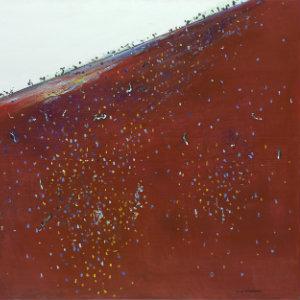The exhibition opens with lesser known works from the artist’s formative years studying in London during the1950’s. Williams was then working in a social realist vein of figurative painting. Acrobats (1955) shows the influence of artists such as Degas and Daumier, taking as its subject music hall entertainers during a performance.
Upon returning to Australia in 1957, Williams somewhat controversially announced an intention to paint gum trees. The Australian landscape had long been a subject for our artists, from the sublime colonial landscapes of Eugene von Guérard to modern masters like Arthur Streeton, but Williams was able to approach it with fresh eyes.
The departure from figurative work leading to the seminal You Yang and Upwey series is well represented in the exhibition. The vast topographies of plains and ridges, the numerous iterations of vegetation pared back to a swirl, a dot or a line and the rejection of a focal point were marks of true innovation. The paintings are dynamic yet finely balanced compositions conveying a strong sense of place.
You Yangs Landscape (1963) at first appears abstract. The pale ochre of the ground in this aerial view hangs between the scatters of green, black and ochre trees. To today’s audiences the floating perspective and markings of dots spread across the canvas will immediately evoke links to Aboriginal Western Desert painting. Yet the works were created separately with Williams’ series pre-dating the Papunya Tula painting movement by a decade. What these works do share however is a powerful connection with the land.
Gouaches from these series are delicately rendered with an almost calligraphic precision. Colourful elements fizz with energy on muted backgrounds in carefully constructed minimalist compositions.
Listerfield triptych (1967-68) is as grand in scale and ambition as a Von Guérard, however its powerful resonance lies in its daring emptiness. The artist remarked that ‘works like this are the hardest pictures I ever had to paint, although on face value they looked to be the easiest’. Vividly coloured blues and purples, applied in dabs and smears, combine with more opaque brushwork floating in the golden background; it represents an artistic highpoint and is a painting that commands attention.
The exhibition shows that the 1970’s was another transformative period for Williams; works here include portraiture, still life and detailed studies of vegetation. The landscapes in this section are not the famed arid plains and baked deserts but ponds, seascapes and depictions of riotous growth in Mount Kosciusko, Bass Strait and the Victorian coastline. In this period Williams emerges as an opulent colourist. The series of four perspectives of a waterfall show an intellectual rigour and engagement with the working methods of Cezanne and a deep grounding in classical modernism.
The last group of paintings in the exhibition are Williams’ works from the Pilbara region in Western Australia, in which his artistic vision culminated. This was the last series he produced before his untimely death at 55 years of age. These brilliantly coloured, vivid representations capture the immensity of the Australian desert and have rightly achieved iconic status. In Iron ore landscape (1981) the horizon is tipped on a diagonal contrasting clear sky and red earth. Spots of blue and yellow scatter across the land to produce an energetic symmetry. The effect is dizzying and dreamlike. In Strath Creek Falls VII (1979) a waterfall dissects the canvas and deep red and yellow ochres are offset by jewel toned dabs and marks. Williams allows us to tap in to his profound experience of the landscape which he translated with paint.
This retrospective allows viewers to appreciate and process the many distinctive elements worked and reworked throughout William’s career, as well as the breakthroughs which constantly propelled him forward. Williams’ paintings offer a fresh and startling experience of the Australian landscape to a new generation of audiences.
Rating: 5 stars out of 5
Fred Williams – Infinite Horizons
Ian Potter Centre, National Gallery of Victoria
Federation Square
April 7 – August 5





